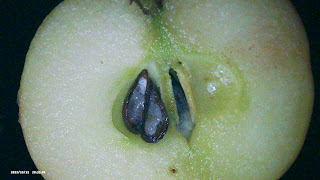The Field Studies Council gives an excellent fold out guide to fruits and seed dispersal. This post is going to work through the guide and see how many examples we have on the Park.
The first page deals with what they are referring to as 'takeaways'.
The first is Blackberry which have now all gone and been eaten by animals. Their seeds pass unchanged through the animals digestive system.
The second is the Holly, there are not many Holly trees on the Park and they are mostly on the west side nearer to the road. The berries will be eaten by birds which are attracted to the red flesh with a seed inside.
Elderberries seem to ripen quite early in the Autumn and are soon dispersed, almost certainly being eaten by birds.
Hawthorn berries are prolific this year. We have got the Common Hawthorn as opposed to the Midland Hawthorn. The Common Hawthorn has just a single seed which once again passes through the digestive system of birds and animals which eat it.
Sloes are the fruit of the Blackthorn shrub. They are virtually inedible until ripe and contain a single stone hidden in the flesh.
Crab apple trees are not common on the Park but they do fruit prolifically. The actual fruit is very hard and sour being virtually inedible until it ripens and falls to the ground. It contains seeds as apple pips.
The next section deals with large seeds. These usually fall to the ground where most are taken away and eaten by animals. The first one is the fruit of the Horse Chestnut or 'conker'.
Along the Woodland Walk you may find 'Cleavers' the seeds of which appear to be sticky but instead they have have minute hooks which hang onto clothing.
On the open grassland you can find the yellow flowering Agrimony in the summer and once again the seedheads have hooks which will catch on to clothing or passing animals.
The next are the seeds which are dispersed by the wind called 'the spinners'. The first are the 'aeroplanes' of the Field Maple.
The Hornbeam is quite a common tree on the Park and produces huge amounts of seed which have wings and spin down to the ground.
There are not many fir trees on the Park but they all produce cones and inside the cones are seeds with a papery wing. When the cones ripened and the scale is open the seeds fall out and spin down on the wind. The first is the Cedar of Lebanon cone and the second is a Scots pine type tree.
The Lime tree produces seeds in pairs with a wing attached and they come spiralling down from these tall trees to the ground.
The first are Creeping Thistle seeds which have a sort of parachute but the seed head is compact and dispersal is not very efficient.
The second is the Willow Herb found by the freshwater spring and down by the river.
And last in this section is the Hardhead or Black Knapweed.
There are two examples of seeds dispersed by water on the Park. The first is the Yellow Flag Iris which grows by the freshwater spring. The seed containers are large and I think that the seeds must be buoyant.
The second is the Alder tree which grows in the Osier Bed. The tree produces small cones and the seeds are very tiny and light.
The next are often referred to as the 'slingers' which means that they have some way of throwing the seed away from the parent plant. The first is the Himalayan Balsam which is an invasive plant by the river. It's green seedpods build up an internal tension until they finally explode and throw the seeds in all directions.
The second plants that produce seedpods are ones such as the Meadow Vetchling. As the seedpods dry and ripen they gradually build up an internal tension and all of a sudden the pod splits and twists throwing the shiny seeds in all directions.













.jpg)













































No comments:
Post a Comment